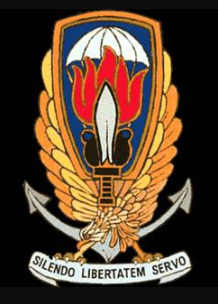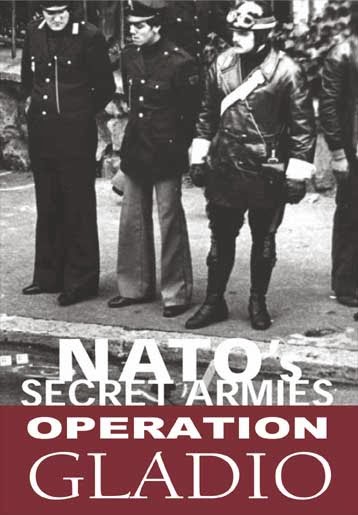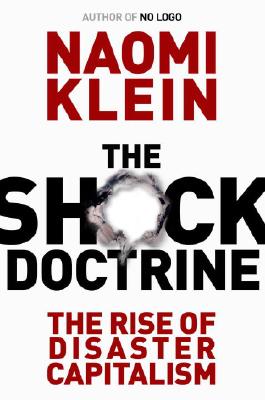by Paul Cudenec

(The following piece was originally published in Paul Cudenec‘s 2013 collection of essays “Antibodies, Anarchangels, and Other Essays“. We are posting it now in English, French, and Spanish, because we believe that it is important that people understand NATO’s history of crimes against humanity. It is a historical fact that NATO has sponsored right-wing terrorism to further its military strategy, and as the conflict heats in the Ukraine, we should be aware that of their repertoire of dirty tricks.)
The fear of “terrorism” is an important tool for the plutofascist system in its attempts to intimidate its slaves and stop them from breaking free from exploitation and control.
But how would things look if we could show people that far from protecting them from some insidious threat, the system is itself that threat? How would things look if we could show them that the real terrorists are those in power?
This is not fanciful thinking – all we have to do is point people towards fully documented historical facts about the recent history of Europe.
After the end of the Second World War, the USA and UK secretly set up a network of “stay-behind” guerrilla units across western Europe, ostensibly to form a resistance movement in the event of a Soviet invasion.
After the end of the Second World War, the USA and UK secretly set up a network of “stay-behind” guerrilla units across western Europe, ostensibly to form a resistance movement in the event of a Soviet invasion.

However, they quickly became part of efforts to keep radical movements from challenging capitalism and acted as terrorist cells, murdering hundreds of innocent people in a “strategy of tension” to scare the public into the arms of the state. Gladio – as this network is known – is certainly not a widely acknowledged reality or a central part of the contemporary political background, but the facts have all been in the public sphere for some time now.
After many years of suspicions and rumours, initial confirmation of Gladio’s existence came in Italy in 1974 as part of a probe into right-wing terrorism by investigative magistrate Giovanni Tamburino.

He arrested General Vito Miceli, chief of the Italian military secret service SID, on a charge of “promoting, setting up and organising, together with others, a secret association of military and civilians aimed at provoking an armed insurrection to bring about an illegal change in the constitution of the state and the form of government”.
At his trial in November of that year, Miceli revealed the existence of a special section of SID, saying (in the words of this rather clumsy translation): “A Super SID on my orders! Of course! But I have not organised it myself to make a coup d’état. It was the United States and NATO who asked me to do it!”.
And 16 years later, in 1990, an official confirmation came from Italian Prime Minister Giulio Andreotti, again as a result of Tamburino’s investigations.
Andreotti revealed that, as far as Italy was concerned, a paramilitary movement had been set up immediately after the war and later formalised, in 1956, in a secret agreement between SIFAR (Italian military intelligence) and the CIA.
Says author Philip Willan, an expert in Italian political intrigue and author of a 1991 book on the subject: “Senior members of the network attended courses run by the Training Division of the British Intelligence Service. It was clear from the report that the organization had been in large part financed and controlled by the CIA”.
“It was clear that the organization had been in large part financed and controlled by the CIA”.
On November 5, 1990, after Andreotti had already released details of Gladio, a NATO spokesman issued an official denial, stating firmly: “An organization of this kind does not and never has existed within the framework of the NATO military structure”.
But the next day a different spokesman had to issue an embarrassed retraction, saying the previous announcement had been “a mistake” and that NATO had no comment to make on the subject!
Shortly afterwards, the European Parliament passed a resolution condemning the network and saying it “protests vigorously at the assumption by certain US military personnel at SHAPE (Supreme Headquarters Allied Powers Europe) and in NATO of the right to encourage the establishment in Europe of a clandestine intelligence and operation network”.
Obviously Andreotti and Italian president Francesco Corsica were not going to actually own up to any link between Gladio and terrorist attacks, but with connections already being made to the secret services, it did not take much of a leap of imagination to start to fill in the gaps and subsequent research and information leaves us with a pretty clear picture of what was going on.
Gladio’s cover story of providing a “stay-behind” anti-Soviet network was undermined by the discovery of some of its arms caches buried at secret locations around Italy. The weapons largely consisted of Kalashnikovs and other Soviet guns, plus explosives from Czechoslovakia. As Willan comments, why would the Americans and British go out of their way to supply groups with Eastern Bloc weapons if they were really intended to fight a Soviet invasion? The only obvious purpose is to use them to commit acts that can then be blamed on left-wing groups and the communist bloc.
In 1992 BBC2 screened a Timewatch documentary on Gladio by Allan Francovich, showing the close links between terrorists and western intelligence operatives. The film, Operation Gladio, can still, at the time of writing, be found on YouTube.
The review in The Times at the time stated: “It was one of those programmes which you imagine will bring down governments, but such is the instant amnesia generated by television you find that in the newspapers the next morning it rates barely a mention”.
Francovich went on in 1995 to make The Maltese Double Cross about the 1988 Lockerbie bombings. He died from a heart attack under mysterious circumstances upon entering the USA at the customs area of Houston, Texas, on April 17 1997.
Meanwhile, the investigations carried on, particularly in Italy. An Italian parliamentary commission into the country’s years of terrorism concluded in 2000: “Those massacres, those bombs, those military actions had been organised or promoted or supported by men inside Italian state institutions and, as has been discovered more recently, by men linked to the structures of United States intelligence”.
“Those massacres, those bombs, those military actions had been organised or promoted or supported by men inside Italian state institutions and, as has been discovered more recently, by men linked to the structures of United States intelligence”.

There were even confessions from the horse’s mouth. In March 2001 General Giandelio Maletti, former head of Italian counter-intelligence, admitted:
“The CIA, following the directives of its government, wanted to create an Italian nationalism capable of halting what it saw as a slide to the left and, for this purpose, it may have made use of right-wing terrorism”.
The implications of all this are obviously enormous. As American author and intelligence analyst John Prados has commented: “In this age of global concern with terrorism, it is especially upsetting to discover that western Europe and the United States collaborated in creating networks that took up terrorism. In the United States such nations are called ‘state sponsors’ and are the object of hostility and sanction. Can it be the United States itself, Britain, France, Italy and others who should be on the list of state sponsors?”
Perhaps it is not so difficult to see why, despite the mountain of evidence on Gladio, it is still not widely mentioned in our media.
How did it all start? Well, dirty tricks go back a long way – from ancient Greece and Rome, through to the British Empire and the current day, all across the world and in all sorts of circumstances. The term “false flag”, now often applied to terrorism carried out by someone other than it appears, originally came from a naval trick of attacking another force while flying the flags of an enemy, to prompt retaliation against the wrong target. Any power struggle or war has probably involved elements of deceit and manipulation.
But, for the purposes of this account, we will start the story at 9.15pm on the night of February 27, 1933, when a Berlin fire station received an alarm call that the Reichstag building, the home of the German Parliament, was ablaze.

The police quickly found a shirtless Dutch communist called Marinus van der Lubbe. He and four communist leaders were arrested and it was declared that the communists were beginning a plot against the German government. Adolf Hitler, who had been sworn in as chancellor four weeks previously, urged President Hindenburg to pass an emergency decree in order to counter the “ruthless confrontation of the KPD”.
The passing of the Reichstag Fire Decree and then the Enabling Act led to the communists being barred from elections, various dissident papers being suppressed and generally allowed Hitler to take over the role of dictator.
In 1990 material from the Gestapo archives held in Moscow became available to researchers for the first time and a 2001 work by two German authors, Alexander Bahar and Wilfried Kugel, demonstrated that the fire was almost certainly started by the Nazis themselves.
We now jump across the North Sea and forward five years to 1938, when, with war with Germany looming, a report on guerrilla warfare by Major Lawrence Grand of the British army, suggested: “The use of organisations already existing in Germany, eg: the Communists”. Using communists against fascists or fascists against communists – it was all fair game in British Realpolitik.
In 1939 Colonel Colin Gubbins produced some papers on guerrilla warfare. In The Secret History of SOE – the Special Operations Executive, historian William Mackenzie notes: “In their final form, they consisted of three slender pamphlets printed on rice paper and bound in brown cardboard covers without indication of their contents.
“The original intention was to have them translated into various languages, but it is not at all clear what use was eventually made of them. They were entitled The Art of Guerrilla Warfare (22 pages), Partisan Leader’s Handbook (40 pages) and How to Use High Explosives (16 pages plus diagrams)”. Mackenzie writes of The Art of Guerrilla Warfare: “It is plain… that the doctrine is largely drawn from British experience in the offensive under Lawrence, on the defensive in Ireland, Palestine, the North-West Frontier and Russia”.
By 1940, after Dunkirk, Britain was thinking as much about anti-Nazi resistance at home as on the continent. In May of that year Col. Gubbins formed a new British resistance network to be supplied with the best weapons available and modern plastic explosives. It was highly secretive and its name, “Auxiliary Units”, was chosen to be as nondescript as possible. It’s still secret today, in fact, with official documents not to be released until 2020.

Author Daniele Ganser comments in his authoritative 2005 book Nato’s Secret Armies: Operation Gladio and Terrorism in Western Europe: “These first British Gladio units received special training and were instructed to ‘stay behind’ enemy lines in case of a German invasion of the island.
Operating from secret hideouts and arms caches, they would be able to carry out sabotage and guerrilla warfare against the German invaders”.
Secret underground hideouts we re set up all over England – The Secret Sussex Resistance by Stewart Angell (1996) describes some in Amberley and Arundel Park, with the local HQ at Tottington Manor in Small Dole, near Henfield. They contained arms to blow up railway lines and attack German army convoys plus 50-gallon oil drums filled with an inflammble mixture and buried in roadsides.
This is, in fact, pretty similar to the methods of the Iraqi and Afghan insurgencies against the US/UK occupations at the start of the 21st century. But, of course, such people are terrorists and our boys in the Second World War would have been resistance fighters, which is a completely different kettle of fish!
Britain was never invaded and so the stay-behind network was never activated. But the Germans left fascist stay-behinds as they withdrew across Europe to attack behind enemy lines, including the so-called Werewolves. Experience from these paramilitary operations on both sides of the Second World War was to be used in the anti-communist struggle, with the “stay-behind” resistance networks set up supposedly in case of a Soviet invasion of American-controlled western Europe.
Experience from these paramilitary operations on both sides of the Second World War was to be used in the anti-communist struggle, with the “stay-behind” resistance networks set up supposedly in case of a Soviet invasion of American-controlled western Europe.
The Special Operations Executive had officially been disbanded in January 1946, but was secretly kept alive for the Cold War and on June 30 1947 a new “Special Operations” section was set up within MI6 under Gubbins. SOE personnel remained after the end of the war in Germany, Austria, Italy, Greece, Turkey and elsewhere as part of this new anti-communist operation, working closely alongside the Americans.
Gladio was first coordinated by the Clandestine Committee of the Western Union (CCWU), founded in 1948. After the creation of NATO in 1949, the CCWU was integrated into the Clandestine Planning Committee (CPC), founded in 1951 and overseen by the SHAPE (Supreme Headquarters Allied Powers Europe).

In Britain, the Special Operations Executive – which had formed the wartime stay-behind units – was, naturally enough, involved. While the USA provided much of the funding for Gladio, Britain played a major role. There was a base near London and Gladio recruits trained with the SAS at Fort Monckton near Portsmouth, at Poole and also at Hereford – home of the SAS.
What sort of people were recruited to become part of this pan-European network? Ganser, the author mentioned earlier, notes wryly that in Germany in 1945 “the supply of thoroughly anti-communist men trained in guerrilla warfare and experienced with arms and explosives was abundant”. Former Nazis were used to set up a stay-behind network, including “Butcher of Lyon” Klaus Barbie and Hitler’s spy chief Reinhard Gehlen.
Former Nazis were used to set up a stay-behind network, including “Butcher of Lyon” Klaus Barbie and Hitler’s spy chief Reinhard Gehlen.
SPAIN
Elsewhere, fascist veterans of the Spanish Civil War, militants from Mussolini’s last-stand Salo republic and other right-wing extremists were recruited and formed into squads of nine men, with two leaders. They were armed with light machine guns and hand grenades.
Similar networks were set up all across Europe, and we’ll just briefly look at the sort of things they were up to before returning to the place where it all first went public – Italy.
Under Franco it has been said that Gladio was the actual government. CIA instructors trained European fascists in the Spanish Canary Islands. Parliamentarian Antonio Romera, of the Spanish United Left opposition party investigated and found Gladio in Spain had “acted against militant Communists and anarchists, such as against the miners of Asturias and the Catalan and Basque nationalists”.
In 1977, two years after Franco’s death, a secret stay-behind army, with the support of Italian right-wing terrorists, carried out the Atocha Massacre in Madrid, attacking the offices of a lawyer
connected to the Communist Party and killing five people.
PORTUGAL

A front organisation called Aginter Press was set up, backed by the CIA and used to recruit and direct fascists, backing Salazar’s regime at home and in Portugal’s African colonies. Anarchist Stuart Christie, in his book Stefano della Chiaie, says of Aginter Press’s activities in the Portuguese African colonies: “Their aim included the liquidation of leaders of the liberation movements, infiltration, the installation of informers and provocateurs and the utilisation of false liberation movements”.
In Mozambique in 1969 Aginter Press assassinated Eduardo Mondlane, President of the Mozambique Liberation Party and leader of the FRELIMO movement. It is also believed that Portuguese and CIA agents from Aginter Press worked with Italian right-wing groups like Ordine Nuovo to plant bombs in Italy in 1969, which were blamed on left-wingers.
BELGIUM
In 1950 Gladio cells are thought to have been involved in the assassination of communist leader Julian Lahaut. In the 1980s, a horrific series of terrorist attacks was carried out, resulting in 28 deaths. Many suspect the Belgian branch of Gladio was involved.
In an article in The Observer on June 7 1992, Hugh O’Shaughnessy wrote: “The objective of the exercise had been twofold: to jolt the Belgian police into a higher state of alert and, no less important, to give the impression to the population at large that the comfortable and well-fed Kingdom of Belgium was on the brink of red revolution”.
GREECE
From the end of the war there was a long and bloody battle by Britain and the USA to keep the left out of power. When Greece joined NATO in 1952, the country’s special forces, the LOK, were integrated into Gladio. Former Greek defence minister, Yannis Varvitsiotis has since admitted: “Local commandos and the CIA set up a branch of the network in 1955 to organise guerrilla resistance to any communist invader”. In 1967 they were involved in a CIA-backed military coup one month before elections which the left was expected to win. This established the right-wing “Regime of the Colonels”, which ran Greece until 1974.
TURKEY
The stay-behind army was known as “Counter-Guerrilla” and closely linked to the MIT, the Turkish intelligence agency. It was involved in domestic terrorism, killing hundreds of people as part of a “s trategy of tension” that led to two military coups d’état in which it was directly involved – with secret American support – in 1971 and 1980 and more than 1,000 wounded in political violence. But during the same years in another part of Europe, 2,618 were killed and more than 33,000 injured. Where was that nightmarish place? Northern Ireland. And what is the state often accused of involvement in the violence? Britain.
BRITAIN
We can’t do anything more here than scratch the surface of the history of the troubles, but if we could, we might want to look more closely at:
* Freddie Scappaticci, alias Stakeknife, the British agent who infiltrated the IRA to run its internal security and ordered 40 people to be murdered as security risks – presumably the wrong ones. He’s now said to be living in Italy, where he no doubt feels very much at home.
* Brian Nelson, the British agent who became the intelligence chief of the loyalist Ulster Defence Association – performing a similar role on the other side of the deadly maze of mirrors.
* The Birmingham Six, Guildford Four, and the Maguire Seven – all people wrongly convicted of republican bombing atrocities. Or maybe we should put some inverted commas around “republican”, because if they’re not responsible, who knows who was really behind the outrages and why the British establishment was so keen to find someone to blame for them. Incidentally, the Birmingham bomb led to the 1974 Labour government passing the original Prevention of Terrorism Act.
* Question marks remain over the Omagh bombing of August 15 1998, generally blamed on a republican splinter group. Suspicious minds have pointed to the fact that public horror at the attack, in which 29 people died, allowed Tony Blair’s government to rush through controversial “emergency” anti-terrorist legislation, in the form of the Criminal Justice (Terrorism and Conspiracy) Act 1998, less than a month later in September 1998. This allowed people to be convicted of belonging to a proscribed organisation merely on the say-so of a senior police officer, created an offence of conspiracy to commit offences abroad and generally prefigured more recent terrorist legislation. Helpfully, it included a clause giving “all crown agents immunity from prosecution under the legislation”.
*Constant suspicions of the involvement of the British state in sectarian killings, which still won’t go away, even though its focus switched suddenly to a new “war on terror” just as the “troubles” were declared over. Questions have been asked about state involvement in the deaths of Rosemary Nelson, loyalist Billy “King Rat” Wright, catholic Robert Hamill and RUC officers Harry Breen and Bob Buchanan.
In 2012 Prime Minister David Cameron was forced to admit that the level of state collusion uncovered by a report into the murder of Belfast solicitor Pat Finucane was “shocking” – though the report predictably concluded there had been “no overarching state conspiracy”. No, of course not.
There is an overspill into mainland politics as well, with researcher Larry O’Hara, for example, pointing to a state agenda to reflect the IRA/Loyalist battleground with an anti-fascist/extreme-right conflict in England, by use of infiltrators, agents provocateurs and pseudo-gangs. The 1999 nail bombings bombings in London, supposedly carried out alone and unaided by a right-wing extremist David Copeland, come under some suspicion, not least because the authorities seem to have known, in advance, exactly what area he would target with his final bomb.
There are, of course, continuing questions marks over recent “Islamic” terrorist attacks, with theories abounding over who was really responsible for 9/11 or 7/7 and attention drawn to the links between British and American intelligence services, Pakistani intelligence services and groups like Al Qaeda – suddenly on “our side” in Syria.One state organisation heavily involved in the dirty war in Ireland was the SAS. Glorified by the right-wing media, this elite and secretive branch of the military is in fact more or less Britain’s answer to the SS.
Formed in 1942 to strike behind enemy lines in North Africa, it was disbanded at the end of the war in October 1945, its job apparently over. Adds Ganser in his book on Gladio: “Yet as the need for top-secret dirty tricks and daredevil operation resurfaced as quickly as the global power of the British Empire was declining, the SAS was reborn and in 1947 fought behind enemy lines in Malaysia”.
Since then, the SAS has remained at the forefront of British imperialism – it stormed the Iranian embassy in 1980, fought in the Falklands War in 1982, the First Gulf War in 1991, and secretly trained and equipped Kosovo Liberation Army forces in 1999, in close liaison with their friends in the US Green Berets, a kind of transatlantic twin organisation. In 1990 a BBC documentary called The Unleashing of Evil revealed how the SAS and the Green Berets had used torture against prisoners over the past 30 years and in every major campaign from Kenya to Northern Ireland, Oman, Vietnam, Yemen and Cyprus. The SAS and Green Berets trained Khmer Rouge units in Cambodia under Thatcher and Reagan and the SAS trained the Mujahedin, future Al Quaeda and Taliban fighters, in bomb-making and other black arts in Pakistan in the 1980s and 1990s, as revealed by John Pilger in his book The New Rulers of the World.
Current SAS roles are said to include “Counter Terrorism operations inside and outside UK territory; training soldiers of other nations, and training guerrillas in unconventional warfare and counter revolutionary warfare activities in support of UK government Foreign Policy”.
As mentioned earlier, the SAS was definitely involved in Gladio, acting as the training arm for guerrilla warfare and sabotage. Italian stay-behind units were trained in Britain and the SAS built secret hides where arms were stashed in West Germany.
They also collaborated closely with an armed undercover Swiss organisation called P26. They offered training in Britain, with the SAS also visiting Switzerland. The Swiss even took part in a real assault on an IRA arms depot in which at least one IRA activist was killed, reveals Ganser. This insidious role carries on today.
Take Simon Mann, the supposedly “former” SAS man who has admitted being involved in an attempted coup d’état in Equatorial Guinea, along with the late Margaret Thatcher’s son Mark. Or Ben Griffin, the ex-SAS soldier who spoke at a Stop the War press conference in 2008 about Britain’s role in illegally kidnapping people and handing them over to be tortured and was promptly served with a gagging injunction by the British government.
It is sometimes too easy to focus on American atrocities across the world, from Latin American coups to Vietnam or Guantanamo Bay, and turn a conveniently blind eye to the role the British state has played and still is playing, as the USA’s number one partner in crime.
It is sometimes too easy to focus on American atrocities across the world, from Latin American coups to Vietnam or Guantanamo Bay, and turn a conveniently blind eye to the role the British state has played and still is playing, as the USA’s number one partner in crime.

Historian Mark Curtis wrote in Web of Deceit in 2003: “The idea that Britain is a supporter of terrorism is an oxymoron in the mainstream political culture, as ridiculous as suggesting that Tony Blair should be indicted for war crimes. Yet state-sponsored terrorism is by far the most serious category of terrorism in the world today, responsible for far more deaths in many more countries than the ‘private’ terrorism of groups like Al Qaeda. Many of the worst offenders are key British allies. Indeed, by any rational consideration, Britain is one of the leading supporters of terrorism in the world today. But this simple fact is never mentioned in the mainstream political culture”.
“Indeed, by any rational consideration, Britain is one of the leading supporters of terrorism in the world today.”
So what lessons can we learn from all this? Firstly, it is important to acknowledge that there does exist a powerful capitalist military- industrial complex, which is completely ruthless in pursuing its aims. It’s clear that it is not specifically communism that is the enemy of this system – though during the Cold War and specifically in Italy the communists were seen as the main threat – but anything that threatens to block the domination of certain commercial interests. Curtis has written of “Britain’s overwhelming need to keep economic resources in the correct hands – elites who give favourable treatment to western business”.

In his 1988 book The Culture of Terrorism, Noam Chomsky recalls how, in the Second World War, US president Franklin Roosevelt had announced the Four Freedoms that the US and its allies would uphold in the conflict with fascism: freedom of speech, freedom of worship, freedom from want and freedom from fear. Says Chomsky: “The central – and not very surprising – conclusion that emerges from the documentary and historical record is that US international and security policy, rooted in the structure of power in the domestic society, has as its primary goal the preservation of what we might call ‘the Fifth Freedom’, understood crudely but with a fair degree of accuracy as the freedom to rob, to exploit and to dominate, to undertake any course of action to ensure that existing privilege is protected and advanced”.
It’s not just through terrorism or repression that this global control is maintained – there is a whole spectrum of activities ranging from the funding of political parties and the grooming of up and coming politicians, through to the control of the media. We have to acknowledge this as a reality and direct our efforts accordingly. For instance, if this system is ruthless enough to commit acts of terrorism on its own public, or stage coups d’ état to preserve its total grip on power, can anyone really believe it would allow a radical group to take that power away from it by winning an election? It’s not just through terrorism or repression that this global control is maintained – there is a whole spectrum of activities ranging from the funding of political parties and the grooming of up-and-coming politicians, through to the control of the media.
It’s not just through terrorism or repression that this global control is maintained – there is a whole spectrum of activities ranging from the funding of political parties and the grooming of up-and-coming politicians, through to the control of the media.
It’s just not going to happen, any more than genuine radical groups are currently going to be able to seize control of the state through an armed revolution. There’s no point in fighting the state on a terrain on which it is bound to win. We have to look first at more subtle, unstructured, chaotic, organic, subversive methods of bringing about change and winning our freedom, working through flexible protest and direct action, grassroots community activity, alternative media – creating our own parallel structures, if you like.
Secondly, the police spy revelations in the UK media in 2013 hopefully mean that more people realise that state infiltrators and agents provocateurs are not a paranoid invention and do really exist. But we should also be aware that what we know can only be the tip of the iceberg and that the role of state spies is not just to watch or sabotage but also to control the direction groups take.

We should also note that the state’s efforts are particularly successful where there exists an organisational hierarchy which they can take over. Gianfranco Sanguinetti, in his book Of Terrorism and of the State, argues it is easy for secret services to take control of genuine groups and manipulate them to their own advantage: “All secret terrorist groups are organized and run by a hierarchy which is kept secret even from their own members, and which reflects the division of labour typical of this kind of social organization: decisions are taken at the top and carried out by the bottom. Ideology and military discipline protect the true leaders from any risk and the base from any suspicion”.
Obviously this doesn’t just apply to paramilitary groups, but any radical movement. Everyone has a responsibility to think for themselves. If you don’t follow orders, you can’t be used for someone else’s purposes. It’s no coincidence that it is fascist and communist groups – both very hierarchical in outlook – that were successfully hijacked for state purposes.
If you don’t follow orders, you can’t be used for someone else’s purposes. It’s no coincidence that it is fascist and communist groups – both very hierarchical in outlook – that were successfully hijacked for state purposes.

Thirdly, it is clearly important that we should not allow ourselves to be mentally manipulated by terrorism. The head of steam that had been built up by the anti-capitalist movement in the USA, after Seattle and so on, was pretty much dissipated by 9/11 – an example of the Shock Doctrine set out by Naomi Klein in her well-known book. That wave of dissent didn’t really swell up again until the Occupy movement.
Anyone active in radical politics around that time will recall meeting people after the Twin Towers bombing who were saying the world had changed completely now and they couldn’t carry on protesting. On 7/7 at the Stirling camp for the 2005 G8 protests, news came through of the London bombings. Immediately a resolution was proposed, and somehow passed by a system of delegate voting, declaring that in the circumstances “confrontational” protest was no longer appropriate…
We should also learn to tell the difference between armed resistance and terrorism – globally as well as domestically – and be able to spot the possible motivation behind attacks. Ganser writes that the Rote Armee Fraktion and the Red Brigades (although they were eventually both infiltrated) “did not attack mass gatherings of the population, but very selectively targeted individuals whom they thought represented the ‘state apparatus’, such as bankers, generals and ministers whom they kidnapped and often assassinated… Contrary to the terror of the left, the terror of the right aimed to strike fear to the bones of the entire society and hence secretly planted its bombs among the population to kill large numbers indiscriminately in order to wrongly blame the Communists”.
Said the fascist Vinciguerra: “You had to attack civilians, the people, women, children, innocent people far removed from any political game. The reason was quite simple. They were supposed to force these people, the Italian public, to turn to the State to ask for greater security. This is the political logic that lies behind all the massacres and bombings which remain unpunished, because the state cannot convict itself or declare itself responsible for what happened”.
“You had to attack civilians, the people, women, children, innocent people far removed from any political game. The reason was quite simple. They were supposed to force these people, the Italian public, to turn to the State to ask for greater security.
Vinciguerra
Ultimately, the most important weapon in our armoury is information. We should spread knowledge of how the state operates, of the fact that it has used terrorism as a device for its own ends in the past and may well do so again. This is not the same as automatically assuming that every terrorist attack that happens is a fake – that won’t always be the case. But by studying examples from the past and taking the patterns that they tend to follow, we can get a fairly good idea of what is likely to be going on and inform other people of this.
The whole point of state terror is to trick the population into reacting in the way that the state desires.
The whole point of state terror is to trick the population into reacting in the way that the state desires. If the powers-that-be know that nobody is falling for it any more, there will be no point in them using the strategy in the first place.

2 Replies to “The Sordid History of NATO-Sponsored Terrorism”
Comments are closed.